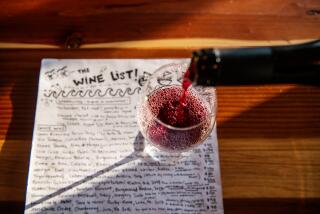Sticky Issue for Wine
The California wine industry got an unexpected boon in 1991 when CBS’ “60 Minutes” spotlighted the so-called French Paradox: a researcher’s findings that moderate consumption of wine could protect against heart disease even in individuals who consumed fatty foods.
Although it is illegal for winemakers to tout their product as a health food, the industry has since basked in the glow of similar studies and has garnered a substantial amount of favorable publicity.
In early 1996, the federal government added to the aura, referring for the first time in its dietary guidelines to scientific evidence that consuming some alcohol can be healthful.
But last month the Wine Institute, a prominent trade organization in San Francisco that represents many of the state’s premium wineries, had to face up to some sobering news: A new research review based on a pooled analysis of six long-term studies among 300,000 women, published in the Journal of the American Medical Assn., found that relatively heavy alcohol consumption--two to five drinks a day--could make a woman 41% more likely to develop breast cancer. For those who consume no more than one drink a day, the increase in risk was quite small.
The report comes as the Wine Institute is trying to win government approval to allow wineries to use a label on bottles that would encourage consumers to learn about the “health effects of moderate wine consumption.” As proposed by the institute, the label would suggest that consumers send away for the U.S. dietary guidelines or visit a World Wide Web site where the guidelines are posted.
The proposed label, the industry hopes, would help counter some of the negatives for wine producers: limits on advertising, “sin” taxes and warnings that must appear on bottles containing alcoholic beverages.
Since the label was proposed two years ago, consumer advocates, led by the Center for Science in the Public Interest in Washington, have complained that it could mislead the public and promote abusive drinking.
“It’s clearly intended as another marketing vehicle,” said George Hacker, the center’s director of alcohol policies projects. “It’s a health claim in disguise.”
The dietary guidelines, Hacker noted, do not address any link between breast cancer and alcohol consumption. Rather, they address only heart disease--and very briefly at that.
John DeLuca, president of the Wine Institute, describes the proposed statement as “an essential education component of our public policy mission.” The Wine Institute, he said, supports the dissemination of scientific research and balanced positions on public health.
To soothe critics, he noted, the Wine Institute revised its proposal. The original language, which referred to the “health benefits” of moderate wine consumption, has been changed to read “health effects.”
“We don’t want people to drink more,” said Elisabeth Holmgren, the institute’s director of research and education. “We want to have [wine] be more culturally accepted.”
Industry observers say the wording of the proposed label is now so benign and innocuous that it is likely to win approval from the Bureau of Alcohol, Tobacco and Firearms.
Seeking to learn the effects of labels on wine bottles, the U.S. Department of Health and Human Services recently conducted a survey in which adult wine drinkers were shown various labels. One key finding was that wine drinkers don’t read wine labels--warnings or any other kind.
(BEGIN TEXT OF INFOBOX / INFOGRAPHIC)
Would You Read This Label?
The Wine Institute has proposed a label for wine bottles that would encourage consumers to seek more information about the health effects of moderate wine consumption. Consumer advocates warn this could lead to abusive drinking. The federal Center for Substance Abuse Prevention surveyed wine drinkers on what they thought about three sample labels. Labels A and B were proposed by the wine industry; label C was created by researchers for the study.
Label A
To learn the health effects of moderate wine consumption, send for the federal government’s “Dietary Guidelines for Americans” (with address and Internet site).
Label B
The proud people who made this wine encourage you to consult with your family doctor about the health benefits and risks of moderate wine consumption. For more information call (800) 729-6686.
Label C
The proud people who made this wine want you to know that it was made with only the finest Concord grapes.
The findings were not impressive:
* Most wine drinkers don’t read wine labels. And those who do would be no more likely to seek health information than those who don’t.
* Neither Label A nor Label B would likely induce wine drinkers to change their drinking patterns. People considered them “condescending” or “marketing ploys.”
* The word “moderate” when associated with drinking has practically no meaning. Moderate ranged from “one to two drinks a month” to “a bottle of wine in an evening.”
* Several wine drinkers said information in the news media about the positive health effects of wine had led them to imbibe more.
Source: Department of Health and Human Services



